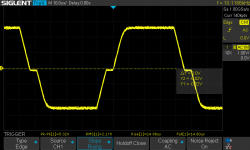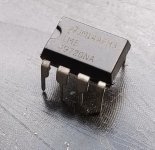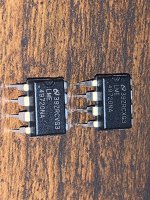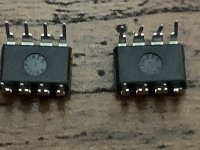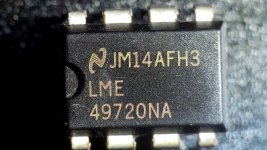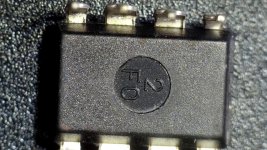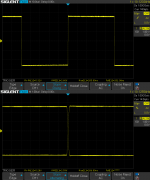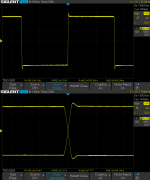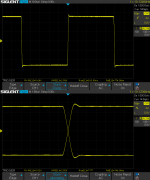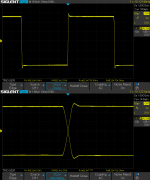Please don't berate me for buying on Aliexpress, I knew what I was getting into! Inspired by videos from JohnAudioTech and the Imsai Guy, I built a little test jig to test slew rate on DIP-8 dual opamps. A way to experiment and potentially to detect fakes. Have tested various NE5532, LM4562, JRE2168 from official and slightly less official sources, all with plausible and acceptable results. I saw LM49720NA advertised on Aliexpress, which I understand to be equivalent to LM4562 so I ordered a handful for $5. Not a big gamble, and an education. I wasn't expecting quite how spectacularly badly they would perform. Attached, an oscilloscope trace of the output from a 10kHz square wave with 11x gain. Slew rate is 70x worse than the official part and there is massive crossover distortion.
I'm just curious what kind of part this could be, because I guess it would be useless as an audio opamp (I haven't tried any listening test).
I put in a dispute with Ali, attaching my oscilloscope trace, but they want photographs showing how the part differs visually from a legitimate one! Think I'll give up now, and just leave some feedback on the seller's page. Amazingly there are lots of happy customers for this very part.
Rob
I'm just curious what kind of part this could be, because I guess it would be useless as an audio opamp (I haven't tried any listening test).
I put in a dispute with Ali, attaching my oscilloscope trace, but they want photographs showing how the part differs visually from a legitimate one! Think I'll give up now, and just leave some feedback on the seller's page. Amazingly there are lots of happy customers for this very part.
Rob
Attachments
Each one has a different three character code on the underside: 2F0, 2B2, 2P3, 2F0. I have tested an authentic LM4562 (which has identical specs... some say it's an identical part) but never had an authentic LM49720.Can u post a pic of the bottom of the chip?
did u test any authentic chips yet?
Attachments
Thanks, that's very helpful. With the difference in underside I might actually have another go at the Aliexpress dispute, since they only accept visual differences to detect fakes.These are authentic.
That's plausible. The fake chip showed zero current on my bench power supply that has 1mA resolution.As duals don't have offset null pins to investigate one way to confirm the die is measure the quiescent current. LM358 is 1mA at 30V supply.
Here are some authentic chip tests. Showing at 10us/div for comparison with the fake, but also (for better evaluation) 1us/div.did u test any authentic chips yet?
LM4562 supplied by Mouser.
Signetics NE5532 extracted from a board.
JRC2068 supplied by LCSC.
TI NE5532AP supplied by Mouser.
Attachments
Both that and heavy crossover distortion confirm LM358 which is a Class B Op AmpThat's plausible. The fake chip showed zero current on my bench power supply that has 1mA resolution.
The hitch in the amplifier square wave response looks characteristic of a slow opamp with a Class B output that can't move fast enough to power through the dead zone. I'd say that you got re-marked LM358s.
As bad as the 4558 is reputed to be, when Raytheon introduced the part, they compared the 10kHz sine response of the 4558 to the LM358 in the data sheet, touting the Class AB bias of the 4558 output stage and showing the lurid crossover distortion exhibited by the LM358 when it was forced to do anything like slew.
Raytheon may have put their thumb on the scale somewhat by making the comparison using a relatively high gain circuit that would have less feedback to help smooth over the rough spots... This would also show the LM358 at a disadvantage.
- Home
- Design & Build
- Parts
- Curious what is this fake opamp (not LME49720NA)
